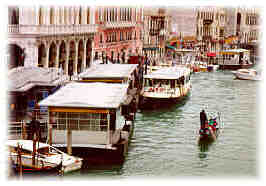
 |
| [Home] [City] [Room] [Board] [Transport] [Books] [Videos] [Links] |
|
|
TransportationAir arrival Alitalia, KLM, and other major airlines fly into Marco Polo Airport, which has an efficient and modern terminal just north of the city on the Venetian lagoon. When you leave the customs hall, go to the money-exchange window and buy some local currency--or use the bancomat ATM. Airport boat: To reach Venice by water, roll your luggage cart through the exit doors and take the shuttle bus to the airport boat's pier. The 45-minute boat ride will take you to the Piazza San Marco, where you can walk to your hotel or catch a local vaporetto at the nearby floating platform. (The boat stops at Murano and the Lido on its way to San Marco.) If you're loaded with money and luggage, or if you're traveling in a group of five or more, you may want to hire a water taxi directly to your hotel. Negotiate the fare before you board the boat, since water taxis don't have meters and are very, very expensive. Another option is an airport bus to the Piazzale Roma, near the train station. The blue ATVO shuttles will get you there in 20 minutes, or you can wait for the much cheaper ACTV orange city bus #5 if you aren't carrying much luggage. Train or car arrival Domestic and international trains discharge passengers at the Stazione Ferroviaria Santa Lucia, an incongruously modern but efficient railway station next to the causeway that leads to the mainland. As you leave the station's main entrance, head toward the floating waterbus platforms. Buy a ticket before boarding the No. 1 vaporetto, which makes stops all along the Grand Canal, or the No. 82 express boat to San Marco. (Note: Large suitcases require tickets, too.) Be sure you're going in the right direction--i.e., toward San Marco unless you're staying in one of the outlying districts. If you're arriving by car, you can try to park in the garage at Tronchetto, an artificial island near the end of the causeway, or the more central garage at Piazzale Roma. But you'll have a better chance of finding a space at the San Giuliano parking lot in Mestre (Venice's industrial suburb on the mainland) and hopping a train or bus into town. In the unlikely event that you're staying at a hotel on the Lido and want to take your car with you, head for Tronchetto as you approach the end of the causeway and take the automezzo, or car ferry, to the Lido. Local transportation On foot. For the most part, transportation within Venice consists of a sturdy pair of rubber-soled shoes or Birkenstocks. Distances are short, although they'll often seem much longer since you're bound to get lost whenever you venture off the well-marked central pedestrian routes. Waterbus. The public boats called vaporetti and motoscafi run almost constantly, and you'll seldom have to wait more than a few minutes for one to come along. The waterbus you'll use most often is the No. 1, the local that stops 13 times between the Piazzale Roma and the Piazza San Marco.. Single tickets are expensive, so--if you plan to use the boat more than a few times during your stay--consider buying a pass for unlimited travel during a one-, three-, or seven-day period. Various types of tourist passes (including a 24-hour family pass for three, four, or five people) are available at any boat platform with a ticket office. Water taxi. The sleek, wood-trimmed water taxis of Venice are convenient but horrendously expensive. Warning: aquatic cabs don't have meters, so know what you're paying before the skipper casts off. Gondola. The gondolas of Venice are beautiful but expensive, and the rate goes up considerably after 8 p.m. Check with the tourist office for current official rates. Gondoliers often demand more money for less time than the official 50-minute hour, so strike a deal in advance, take the Gondola Serenade tour, or leave gondola rides to the ubiquitous flotillas of Japanese tour groups. Traghetto. With just three bridges crossing the Grand Canal's four-kilometer length, Venetians rely on gondola ferries called traghetti at seven points between the railroad station and the Santa Maria della Salute church. Follow the yellow gondola signs down to the water, where you'll pay only a modest fee reach the other side. |
|||
 |
|||
| [Home] [City] [Room] [Board] [Transport] [Books] [Videos] [Links] |